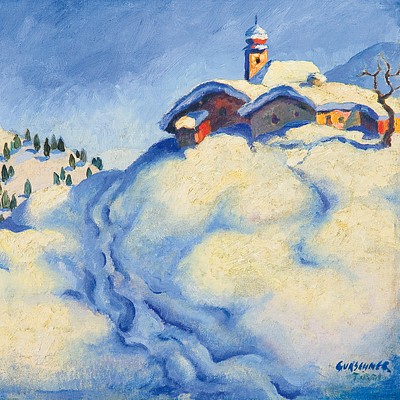PAULA MODERSOHN-BECKER CIRCLE
Lot 132
Estimate:
EUR€800 - EUR€1,600
$860.22 - $1,720.43
Absentee vs Live bid
Two ways to bid:
- Leave a max absentee bid and the platform will bid on your behalf up to your maximum bid during the live auction.
- Bid live during the auction and your bids will be submitted real-time to the auctioneer.
Bid Increments
| Price | Bid Increment |
|---|---|
| EUR€0 | EUR€10 |
| EUR€100 | EUR€50 |
| EUR€700 | EUR€100 |
| EUR€1,000 | EUR€200 |
| EUR€3,000 | EUR€300 |
| EUR€3,600 | EUR€400 |
| EUR€4,000 | EUR€500 |
| EUR€7,000 | EUR€1,000 |
| EUR€16,000 | EUR€2,000 |
| EUR€30,000 | EUR€3,000 |
| EUR€36,000 | EUR€4,000 |
| EUR€40,000 | EUR€5,000 |
| EUR€150,000 | EUR€10,000 |
About Auction
By Widder Auctions
Nov 23, 2023
Set Reminder
2023-11-23 11:00:00
2023-11-23 11:00:00
America/New_York
Bidsquare
Bidsquare : Masterpieces
https://www.bidsquare.com/auctions/widder-auctions/masterpieces-14076
Masterpieces by Austrian and German artists are coming up for auction in Vienna on November 23rd Widder Auctions office@widderauktionen.com
Masterpieces by Austrian and German artists are coming up for auction in Vienna on November 23rd Widder Auctions office@widderauktionen.com
- Lot Description
PAULA MODERSOHN-BECKER CIRCLE
Circle of Paula Modersohn-Becker
Children with Lanterns
oil/cardboard, 62,5 x 53 cm
ESTIMATE °€ 800 - 1600
STARTING PRICE °€ 800
The German painter Paula Modersohn-Becker, née Minna Hermine Paula Becker, was an important representative of early Expressionism. She received her first art lessons at the St. John's Wood Art School in London, founded by Elíseo Abelardo Calderón and Bernard E. Ward. In Bremen she received private painting lessons from Bernhard Wiegandt. In 1898, her uncle Wulf von Bültzingslöwen gave her a trip to Norway as a reward for her successful completion of her studies at the teachers' college; Both of them got to know the paintings of Edvard Munch there. In 1893 she saw pictures of the Worpswede artist circle for the first time in the Kunsthalle Bremen, by Otto Modersohn, Fritz Mackensen, Fritz Overbeck, Hand am Ende and Heinrich Vogler. Modersohn later became Becker's husband. In Berlin she took a course at the drawing and painting school of the Association of Berlin Artists, with Jacob Alberts and Curt Stoeving. In 1896 she began a year and a half of training: portrait painting with Jacob Alberts and Martin Körte, nude painting with Ernst Friedrich Hausmann, and landscape painting with Ludwig Dettmann. During this time she often met Rainer Maria Rilke, whom she later portrayed and who admired her art. A decade earlier, Kätze Kollwitz had studied at the so-called “Women's Academy” of the Association of Berlin Artists. In 1897 Becker was accepted into Jeanna Bauck's painting class at the Ladies Academy. Bauck made her want to go to Paris. In 1899 she met Carl Vinnen and Carl Hauptmann in Berlin. During her years in Berlin, Becker spent a lot of time drawing in museums. Similar to the Nazarenes before them, she particularly valued the artists of the German and Italian Renaissance such as Albrecht Dürer, Lucas Cranach, Hans Holbein the Elder. Ä., Titian, Botticelli and Leonardo da Vinci. Becker repeatedly spent a lot of time in the Worpswede artists' colony and in Paris. The artists of Worpswede, like the Barbizon school founded by Théodore Rousseau, sought a new understanding of nature. From around 1898 she designed Stollwerck pictures on behalf of the Cologne chocolate producer Ludwig Stollwerck together with Otto Modersohn, Fritz Overbeck and Heinrich Vogeler. In Paris she was, among other things, Paula Becker met Auguste Rodin and studied at the Académie Colarossi with Courtois, Collin and Louis-Auguste Girardot. In Paris, Becker visited Ottilie Reylaender, a student of Johann Hinrich Fehr and Fritz Mackensen. Another friend was Clara Westhoff. The Modersohn-Becker couple visited Carl's captain and met the sociologist Werner Sombart there. In Dresden they met Otto Mueller. Inspired by a sculpture shown at the Salon des Indépendants, Becker visited the sculptor Bernhard Hoetger in his Paris studio, which left a lasting impression on her and in her painting. As a result of her second stay in Paris around 1900, monumentality and severity in composition and form became increasingly important in Becker's work, which points to an intensive engagement with Paul Gaugin, Henri Matisse and Paul Cézanne. Furthermore, the stylistic proximity of her children's portraits to the paintings of the young Picasso from the Blue and Pink Periods is striking. Elements of Cubism can be seen in the portraits from 1906 and 1907.
PLEASE NOTE:
The purchase price consists of the highest bid plus the buyer's premium, sales tax and, if applicable, the fee of artists resale rights. In the case of normal taxation (marked °), a premium of 24% is added to the highest bid. The mandatory sales tax of 13%, for photographys 20%, is added to the sum of the highest bid and the buyer's premium. The buyer's premium amounts to 28% in case of differential taxation. The sales tax is included in the differential taxation.
- Shipping Info
-
Shipping Terms
We will send you the invoice shortly after the auction. As soon as we have recieved the amount, the art can be picked up at Johannesgasse 9-13, 1010 Vienna. Please note that the buyer is responsible for pick-up and shipping of the lot.
Should you wish to ship your items, please contact:
Mailboxes
Email: oper@mbe-co.at
Tel: 01 5128855
Please note that storage fees may apply, should the pieces not be picked up within 14 days after invoicing for domestic and 28 days for international transportation.
Our team will be happy to assist you with any further information at office@widderauktionen.com or at 0043 676 555 66 10.
-
- Buyer's Premium



 EUR
EUR CAD
CAD AUD
AUD GBP
GBP MXN
MXN HKD
HKD CNY
CNY MYR
MYR SEK
SEK SGD
SGD CHF
CHF THB
THB













